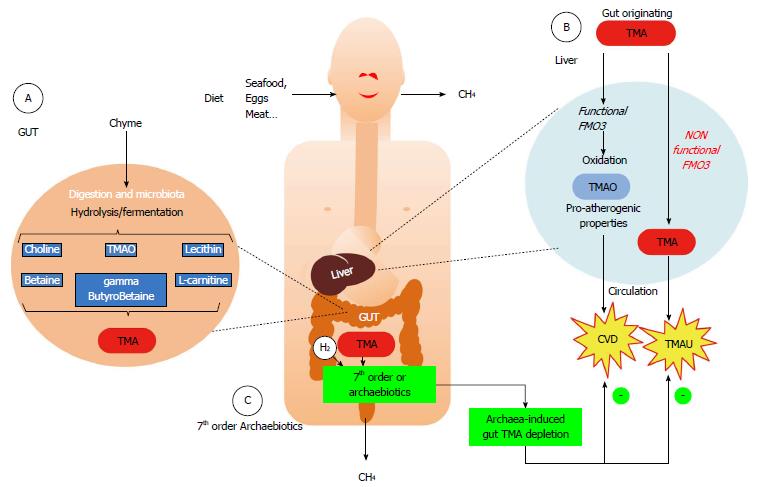Copyright
©2014 Baishideng Publishing Group Inc.
World J Gastroenterol. Nov 21, 2014; 20(43): 16062-16078
Published online Nov 21, 2014. doi: 10.3748/wjg.v20.i43.16062
Published online Nov 21, 2014. doi: 10.3748/wjg.v20.i43.16062
Figure 3 Faith of trimethylamine originating from the gut microbiota metabolism and putative role of representatives of Methanomassiliicoccales.
A: Several common foods (containing lecithin/choline, L-carnitine, trimethylamine oxide,…) are metabolized into trimethylamine (TMA) by some bacterial components of the microbiota; B: When the microbiota does not contain any members of the 7th order of methanogens, the gut-originating TMA reaches the liver, where it is oxidized by the flavin-monoxygenase FMO3 into trimethylamine oxide (TMAO) (Blue arrows in B). This odorless molecule has recently been shown to be associated to cardiovascular diseases (CVD) and has pro-atherogenic properties. In some people however, with a deficiency in liver oxidation, the TMA is not or less metabolized (orange arrows in B) and reaches various body fluids, leading to trimethylaminuria (TMAU) or “fish-odor syndrome”; C: When present, either naturally or by supplementation (Archaebiotics), it is hypothesized that members of the 7th order of methanogens, through their up to now unique metabolism in the gut, might decrease the concentration of TMA by converting it into methane, therefore leading to an archaea-mediated TMA depletion before it can reach the liver. This could therefore be a convenient way to prevent CVD or limit TMAU.
- Citation: Gaci N, Borrel G, Tottey W, O’Toole PW, Brugère JF. Archaea and the human gut: New beginning of an old story. World J Gastroenterol 2014; 20(43): 16062-16078
- URL: https://www.wjgnet.com/1007-9327/full/v20/i43/16062.htm
- DOI: https://dx.doi.org/10.3748/wjg.v20.i43.16062









